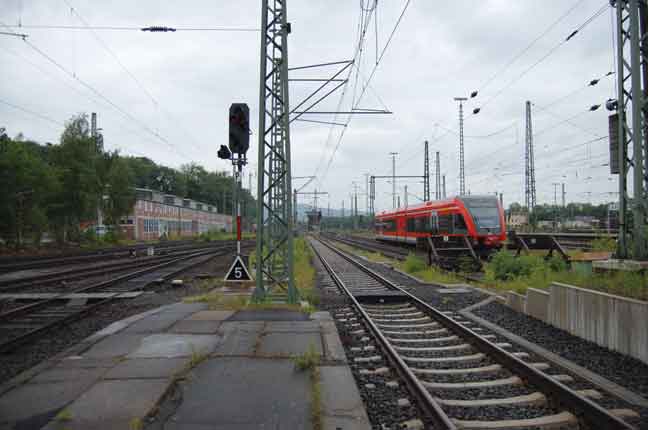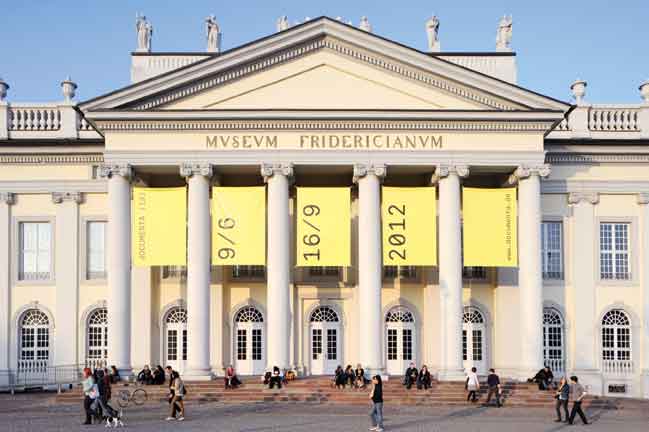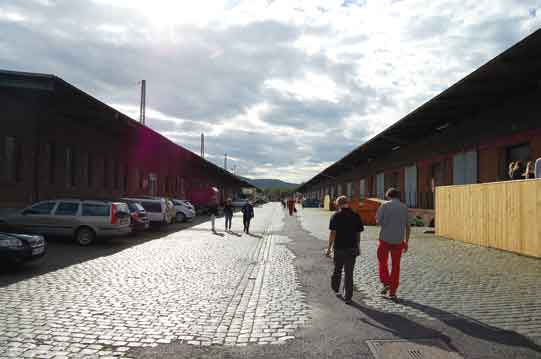« Reviews
dOCUMENTA (13)
By Stephen Truax
One-hundred meters past the end of the platform behind the Hauptbahnhoff-a commuter tram station that used to be the central train station in Kassel, Germany, artist Susan Philipsz positioned her seven-channel sound installation, Study for Strings, (2012). By the same title, Study for Strings is a one-movement work composed by Pavel Haas in 1943 while he was imprisoned in the Terezín concentration camp. It was performed by the Nazi Terezín String Orchestra on September 1, 1944, before an audience during the shooting of the propaganda film Theresienstadt: Ein Dokumentarfilm aus dem jüdischen Siedlungsgebiet (Terezín: A Documentary Film from the Jewish Settlement Area), in which Haas himself is visible.
The Hauptbahnhoff in Kassel served as an important Nazi registration and processing center for Jews before they were funneled to the Terezín or Auschwitz concentration camps. Haas was later sent to Auschwitz from Kassel, where he was murdered that same year. Philipsz’ sound installation appropriates Study and represents it, fragmented, across the very train tracks from which Haas departed to his death.
A romantic and deeply personal approach to trauma, both historical and present, private and political, are ongoing themes of dOCUMENTA (13), the current exhibition. Unlike other major biennials and art fairs, Documenta, the program of contemporary art exhibitions that occur every five years, does not emerge from the history of international expos and world’s fairs as a matter of national pride, but rather, out of trauma. The exhibition was invented by Arnold Bode in 1955 as a method of recovery from the recent history of the Third Reich and the Nazi Holocaust. World War II, genocide, fascism and empire-building still resonate in the contemporary work presented.
dOCUMENTA (13) is divided thematically between the four positions: Kassel (on stage), Kabul (under seige), Cairo/Alexandria (state of hope), and Banff, Canada (in retreat), each location carrying with it obvious political overtones. It actively participates in two recent events: the Arab Spring, personified by the ongoing protests in Tahrir Square, Cairo, and the NATO occupation of Afghanistan, based in Kabul. Additionally, Documenta issued statements of solidarity with protests against the Monsanto Corporation and the Occupy Wall Street movement.
During a public interview several days before the opening in Kassel, dOCUMENTA (13) artistic director Carolyn Christov-Bakargiev (CCB) said her reasoning for making it physically impossible for any one viewer to experience all of her exhibition was to ensure that no visitor to Kassel would believe he or she was at the center of the world. The exhibition aims at “reinventing transnational relationships” and addressing the current possibilities of geopolitics. It forces the viewer to locate him or herself in a specific position: The simultaneous events underscore that one is not here, and not there. “Occupying” four cities around the globe at approximately the same time makes dOCUMENTA (13) a stand-alone symbol of the contemporary art industry, its circuit of biennials and art fairs, and the multinationals that populate it.
Christov-Bakargiev has been working continuously with her curatorial team on this project for the past five years, leaving her position as chief curator at Castello di Rivoli in Turin for the opportunity. It includes over 300 “participants,” not just artists, but also scientists, philosophers, writers, non-human makers and inanimate objects. For 100 days, these four positions will be filled with activity: performances, symposia, readings, film screenings and keynote lectures. Additionally, three beautifully designed catalogs were produced: The Book of Books, which includes 100 Notes, 100 unique works by 100 artists, scholars, designers and curators; The Logbook; and The Guidebook.
The exhibition in Kassel for perhaps the first time extends far beyond the walls of the official venues-the Fridericianum, the Documenta-Halle and the Neue Galerie-to take place in a variety of nontraditional spaces, suggesting a strong, mutually beneficial relationship between Documenta and the city of Kassel. The Ottoneum, the Orangerie, the Hauptbahnhof, Baroque Karlsaue park, as well as galleries, townhouses, hotels and abandoned spaces around the town are all employed with genius selections of work, many of which were site-specific and produced for Documenta. Armed with the overwhelming map of 500-plus sites, dOCUMENTA (13) at Kassel was a scavenger hunt.
Despite these attempts to decentralize the experience of Documenta, the majority of viewers begin at the main entrance to the Fridericianum on the central green. Viewers enter a museum space that is empty, with the exception of a glass vitrine displaying a handwritten letter from Kai Althoff to CCB.
Perhaps the viewer will notice a subtle breeze blowing through the gallery. Are the doors and windows open? Artist Ryan Gander engineered “a light breeze blowing through the Fridericianum’s entire ground floor, whose rooms are left almost entirely empty” for his conceptual artwork, I Need Some Meaning I Can Memorize (The Invisible Pull), (2012). The only visible sign that alerts the viewer to the work’s presence is the wall placard. The title is culled from indie rock band Bright Eyes’ lyric from its 2002 single, “Lover I Don’t Have to Love,” assigning a melancholic overtone to the work.
On a blog, Matthew Shum linked Gander’s action of installing a breeze to Richard Shiff’s Breath of Modernism (Metonymic Drift) (1997), which proposes that in a world saturated with content, media and images, works of art have lost their aura and are detached from their direct ability to make meaning. Shiff describes meaning-moving fluidly between art objects, images and media-as translucent/air/breath. Gander’s project seems to epitomize the current state of contemporary art.
The philosophy behind the exhibition is strictly anti-authoritarian. What object would be placed in the main gallery of the 18th-century museum without purporting to be a commodity object, declaring its own importance? Leave them empty. While ostentatious as it is to present two huge, nearly empty rooms at the center of an exhibition in the spotlight of global attention, the poetry of Gander’s projects echoes throughout dOCUMENTA (13). In the politically charged context of Kassel, where the Holocaust is top of mind, Gander presents open air and empty space instead of prisons; a light breeze, or breath, instead of gas chambers. Leaving the main gallery empty, exhibiting a letter to herself, she and her team actively participating in artworks, leaving the hand of the curator visible throughout the exhibition.
Staunchly anti-market rhetoric was issued in all press releases and marketing materials surrounding the exhibition. dOCUMENTA (13) visibly lacks many discrete art objects, focusing instead on installation, ephemeral works, non-art objects, performance, video and other time-based works.
dOCUMENTA (13) illustrates the matrix system that is contemporary cultural production: Art is interrelated with science, theory and philosophy, history (ancient and contemporary), politics and economics, and other parallel fields. It directly addresses the constantly changing boundaries around what can be considered art.
At the base of the hill on which Kassel is perched are bunkers dug into the cliff face alongside a highway, which were used during the Allied bombing. It was this location where artist team Allora & Calzadilla chose to place their intensely quiet, subtle video, Raptor‘s Rapture, (2012). Deep within the bunker in a relatively small room with a very high ceiling, a high-definition projector is installed with powerful surround-sound speakers. The image is a close-up of a middle-aged woman’s face, standing in a black, silent room. She is Bernadette Käfer, a flautist specializing in prehistoric instruments, and she is struggling to play a tiny flute, thinner than a coffee straw, which is in fact the oldest musical instrument found to date, carved by Homo sapiens 42,000 years ago from the wing bone of a griffon vulture.
She attempts to play the instrument, methodically testing every possible noise she can make with it, in the presence of a living griffon vulture-one of the oldest species continuously living on Earth-which is also the subject of detailed close-ups. The piece recalls Joseph Beuys’ 1974 performance I Like America and America Likes Me, in which he lived for three days in a gallery with a coyote. It is a striking image of human beings’ current relationship with our own history and gives us the opportunity to listen to possibly the first music, the first cultural output, ever made by Homo sapiens.
Human beings categorize their activities into fields and specialize their practices, siloing them from adjacent forms of study and knowledge. At the press conference, CCB elaborated that these categories change throughout history. dOCUMENTA (13) seems to be a deliberate attempt to collapse those boundaries, allowing these related activities to “gain meaning through their interrelation,” i.e., cross-pollinate. Everything is subjective and pluralized when discussing dOCUMENTA (13): truths, knowledges, realms, realities, positions, practices, identities. Whether multiplied or blurred, few participants in dOCUMENTA (13) take only one role, whether artist, curator, philosopher, writer, scientist and/or activist.

Susan Phillipz, Study for Strings, 2012, sound installation at the Hauptbahnhoff. Photo Stephen Truax.
Geneticist Alexander “Sasha” Tarakhovsky, who is head of the Laboratory of Immune Cell Epigenetics and Signaling at The Rockefeller University in New York, created a unique (and perhaps his first) artwork,1 working directly with Chus Martínez (leading curator after the artistic director), as well as serving as an advisor for dOCUMENTA (13). The curators working on dOCUMENTA (13) are called agents, a term also used to describe pathogens in genetics. This play on words was Tarakhovsky’s contribution and became central to the overall concept of the exhibition.
Tarakhovsky has been doing research on epigenetics, a branch of biology that studies how new characteristics are developed and propagated in organisms (other than mutation), for the past 12 years. He presents Epigenetic Reset, (2012), a display of nucleic acid and enzymes in plastic, wood and metal, alongside his own drawings and a polymerase chain reaction (PCR) machine. The machine displays images representing DNA emotionally affected by trauma, clicking through every few seconds. No image will repeat throughout the 100-day duration of the show. The work is displayed alongside Salvador Dali’s painting Espagne, (1938).
In an interview with Hans Ulbrich Olbrist, Tarakhovsky describes it as a “molecular Andy Warhol,” as the machine is capable of making endless numbers of images on behalf of its inventor, and refers to the machine as having a “connection to Marcel Duchamp…in French, as you know, a urinal or pissoir, which equates phonetically with ‘PCR.’”2
The distinction between the art object and any other object of cultural significance is confounded in dOCUMENTA (13). The question “Is this art?” seems largely irrelevant in the context of this exhibition; instead, objects and artworks gain meaning through relationships built between them. The most ambitious work to be included in dOCUMENTA (13) was neither completed, nor was it an art object.
Artists Guillermo Faivovich and Nicolás Goldberg proposed to transport the second-largest meteorite in the world, El Chaco, which weighs 37 tons, from its initial crash site in northern Argentina to Kassel on the occasion of dOCUMENTA (13). It would have probably been the heaviest single object moved transcontinentally for a temporary exhibition. Due to objections from anthropologists and the Moqoit indigenous community, Documenta halted the project on the grounds that its “aspirations were not those of dividing people, but rather of bringing people together through [the project].” The story of this “failed” project, however, became instrumental to the exhibition.
In lieu of a concept, CCB created “the brain,” a glass-walled rotunda at the center of the museum filled with art, objects and curios. Through their interrelation, these objects begin to tell an anti-imperialist/anti-capitalist story of how protest, art, science and history can come together to create new meaning and a new context.
In a public interview days before the opening of dOCUMENTA (13), CCB posed several rhetorical questions to the audience to outline her approach to organizing this iteration of Documenta. “How does one not waste one’s life?” she asked. “What is your connection to the world? How does art transform our political life?” In this moment of global uncertainty, philosophical skepticism, overproduction of content and increasing worldwide interconnectivity, it has become important again to ask the big questions, to investigate what it means to be a cultural producer in the world.
(June 9 - September 16, 2012)
NOTES
1. ‘”Agents of Provocation’ at dOCUMENTA (13): Alexander Tarakhovsky and Epigenetic Reset” Germany.info (German Missions in the United States), July 18, 2012.
2. See, Hans Ulbrich Obrist. “Epigenetic Reset, 2012.” Mousse Contemporary Art Magazine, Issue # 34, 2012.
Stephen Truax is an artist, writer and independent curator based in Brooklyn.
* The first version of this review erroneously described the work of Omer Fast for dOCUMENTA (13), by mentioning that a live camel was included as part of the exhibition. The work of Omer Fast for Documenta consisted of his video Continuity (2012), which addresses the dilemma of a middle-aged German couple whose son, a soldier, has gone to Afghanistan.
Throughout the video, Fast reveals and questions how the departure of a son to war can affect the life of a family. Continuity reflects different moments in the story including the departure of the soldier, who is seen off by his parents at the train station, the pain and anguish that the parents suffer due to the absence of their son, his apparent return home, the dinner they prepare for him to celebrate his return, conjointly with images of the war in Afghanistan and hallucinations suffered by the mother - who at times thinks she sees the figure of a camel that appears in the middle of a rural road in Germany and leads her to the scene of a battle where the body of her son could be among the many bodies of soldiers who died in combat. These scenes are combined with others that show a group of male escorts that the couple apparently hires to substitute for the figure of their son in a fictitious celebration of his return. In Continuity, reality and fiction are overlaid time and time again to the extent that it is difficult to separate them. Through a combination of images with a profound psychological impact, Omer Fast addresses the traumas and aftermath that war leaves on soldiers and their families, as well as the recurring difficulties that soldiers face upon returning home and attempting to reinsert themselves into society in order to continue on with their lives.
Filed Under: Reviews





































Leave a Reply
You must be logged in to post a comment.